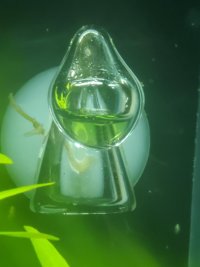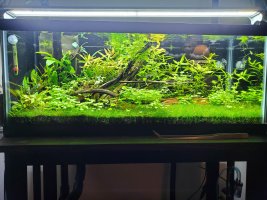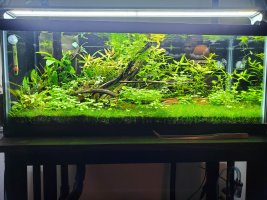NotoriousENG
Member
Hi Everyone
I've been having some ongoing issues with plant health in varying degrees pretty much since I set this tank up (about three months ago). Before I get into the issues some tank details.
Tank: 20 gallon long
Temp: Unheated, 68-72 deg. F
Inhabitants: 1 mystery snail, 2 nerite snails, a few trumpet snails, approx. 20 neo shrimp, and about a billion limpets. Once the shrimp population rises I will be adding 10 to 15 white clouds
Filter: 10-gallon sump with three two-inch-thick sheets of poret foam, filter fleece, and purigen. Water returns to the tank via a split loc line return. Flow throughout the tank seems to be good with some areas bordering on too high. The back right seems to be the lowest flow area. I also have a quick video showing the flow. I have an adjustable DC return pump so can dial up or down the flow as needed.
C02: Pressurized, inject via cerges reactor, on three hours before lights on and off one hour before lights off. About three bubbles per second of gas which causes a gas build-up in the reactor and starts spitting microbubbles a few hours into the photoperiod. Since I get the build-up, I don't know if running a higher injection rate would do much good since the reactor seems to be saturating. When the drop checker is in the front of the tank it is lime green, almost yellow at lights on. In the back of the tank, under the outflow (lowest flow portion of the tank), it is lime green as pictured. I don't have a pH probe but appear to have at least a one-point drop using the liquid kit. Degassed tank water is at the top of the API low range kit and near the bottom of the high range kit, (about 7.6~7.8). The pH drops to about 6.4 wth CO2 on as far as I can tell.

Light: 36" Finnex Ray2 DS hanging about 3" above the tank (since the tank is only 30" long). On 7.5 hours per day
Substrate: Black diamond blasting sand (coal slag) with a little bit of boiled worm castings, red clay, KCL, dolomite, and osomocote plus on the glass.
Dosing: See the picture below. Note that Fe DTPA dosing was started the first week of September, K was increased from 18 to 25 ppm on October 9th, iron and trace was increased to current levels on October 17th


All of the plants show decent growth rate. The hydrocoytle grows like wildfire and looks healthy. The crypts and anubias seem healthy and average about 1-2 leaves a week. The dwarf hairgrass has also been spreading nicely. I see good pearling midway through the photoperiod. The anubias has the most pearling while the ludwigia consistently has the least. No real algae except some persistent minor diatoms and a very small amount of green spot on some of the hardscape. I do occasionally see clearish thread algae on dead and melting leaves but it seems to leave the health growth alone.
Now the issues.
I have two species of ludwigia in this tank. I thought one of them is was L. repens but the leaves are way larger (about the size of my thumb) then I recall them being. The undersides are also pretty much devoid of any red. The other species have longer thing leaves and is also unknown to me. Since pretty early in this tank's life, I have seen pale growth on my ludwigia. Until it gets within a few inches of the surfaces the leaves are very pale whitish-green. The larger leaf variety has also have very noticeable white veins. Once the leaves are within a few inches of the light the leaves to develop some orange coloration and look better. However, they still have pale, have white veins, and lack red undersides. Some of the leaves also develop some twisting.


I also have some buce that originally came from tissue culture. When I first got it every single leaf melted off leaving only the rhizome. The buce are slowly clawing their way back to life and putting up new leaves. However, they also seem to be very pale. Not sure if the leaves come in pale and darken like anubias leaves?

The rotala also looks a little pale and generally looks kind of crappy with some leaf twisting as well.

I originally thought the paleness was due to low iron since my pH before Co2 is in the mid to upper sevens. So I started dosing Fe-DTPA and it seemed to help a little but with overall growth rate and health, but the paleness persists.
The bigger issue is reoccurring necrosis and melting of the ludwigia, frogbit, and dwarf hair grass. On the ludwigia, leaves and stems turn pale gray then melt away. Not all stems are affected and it usually occurs on the lower portion down areas. New growth is also affected if it is lower down in the tank (after trimming or an offshoot). Some of the plants have very nice-looking tops but bottoms that have turned to mush. The melting is mostly concentrated on the ludwigia on the right side of the tank. The ludwigia on the left near the wood (directly under the lights and in a very high flow area) generally looks much healthier.





I also consistently see some yellow, dead, or melting leaves in my dear hair grass carpet. Although the dwarf hair grass generally seems to be pretty healthy. The few pieces of frogbit I have in the tank also show necrosis and dead spots..

Lastly, my Java fern also ocassiaonly gets clearish tips and brown patches on the older leaves

At this point, I am at a loss as o what the problem is. I feel like it probably isn't ferts or CO2 since both should be plenty high. The pale leaves might be due to the fact that the finnex ray2 has only 7000k LEDs so tends to heavily wash out pretty much any color but green. On my last tank (back in 2016) I used the same light and could never really get any of the plants red.
Since the melting seems to occur on the back lower right-hand portion of the tank I am thinking either flow or light. The back lower right seems to be the lowest flow and also the dimmest area of the tank. If I look closely I can see the leaves on the lower right waving slightly. That coupled with the fact that there was heavy melting about an inch from a lime green drop checker makes me lean away from the flow and towards the light. More specifically light spread.
I did some quick math and assuming a 120-degree lens on the LEDs the light should cover the full front to back width of the tank at the surface. However, I realized that I was off with my hole placement and the light ended up a little forward of the centerline. I did raise the light a bit tonight to hopefully get some more spread but am not opposed to replacing it if it is the problem (I am tired of washed-out colors anyways).
I am thinking about moving the outflow to the center of the tank and drilling some holes along the loc line arms to give better flow distribution. However, I would like to avoid doing so unless flow is the likely culprit.
Any help y'all can offer is greatly appreciated since this is stressing me out!
I've been having some ongoing issues with plant health in varying degrees pretty much since I set this tank up (about three months ago). Before I get into the issues some tank details.
Tank: 20 gallon long
Temp: Unheated, 68-72 deg. F
Inhabitants: 1 mystery snail, 2 nerite snails, a few trumpet snails, approx. 20 neo shrimp, and about a billion limpets. Once the shrimp population rises I will be adding 10 to 15 white clouds
Filter: 10-gallon sump with three two-inch-thick sheets of poret foam, filter fleece, and purigen. Water returns to the tank via a split loc line return. Flow throughout the tank seems to be good with some areas bordering on too high. The back right seems to be the lowest flow area. I also have a quick video showing the flow. I have an adjustable DC return pump so can dial up or down the flow as needed.
C02: Pressurized, inject via cerges reactor, on three hours before lights on and off one hour before lights off. About three bubbles per second of gas which causes a gas build-up in the reactor and starts spitting microbubbles a few hours into the photoperiod. Since I get the build-up, I don't know if running a higher injection rate would do much good since the reactor seems to be saturating. When the drop checker is in the front of the tank it is lime green, almost yellow at lights on. In the back of the tank, under the outflow (lowest flow portion of the tank), it is lime green as pictured. I don't have a pH probe but appear to have at least a one-point drop using the liquid kit. Degassed tank water is at the top of the API low range kit and near the bottom of the high range kit, (about 7.6~7.8). The pH drops to about 6.4 wth CO2 on as far as I can tell.
Light: 36" Finnex Ray2 DS hanging about 3" above the tank (since the tank is only 30" long). On 7.5 hours per day
Substrate: Black diamond blasting sand (coal slag) with a little bit of boiled worm castings, red clay, KCL, dolomite, and osomocote plus on the glass.
Dosing: See the picture below. Note that Fe DTPA dosing was started the first week of September, K was increased from 18 to 25 ppm on October 9th, iron and trace was increased to current levels on October 17th
All of the plants show decent growth rate. The hydrocoytle grows like wildfire and looks healthy. The crypts and anubias seem healthy and average about 1-2 leaves a week. The dwarf hairgrass has also been spreading nicely. I see good pearling midway through the photoperiod. The anubias has the most pearling while the ludwigia consistently has the least. No real algae except some persistent minor diatoms and a very small amount of green spot on some of the hardscape. I do occasionally see clearish thread algae on dead and melting leaves but it seems to leave the health growth alone.
Now the issues.
I have two species of ludwigia in this tank. I thought one of them is was L. repens but the leaves are way larger (about the size of my thumb) then I recall them being. The undersides are also pretty much devoid of any red. The other species have longer thing leaves and is also unknown to me. Since pretty early in this tank's life, I have seen pale growth on my ludwigia. Until it gets within a few inches of the surfaces the leaves are very pale whitish-green. The larger leaf variety has also have very noticeable white veins. Once the leaves are within a few inches of the light the leaves to develop some orange coloration and look better. However, they still have pale, have white veins, and lack red undersides. Some of the leaves also develop some twisting.
I also have some buce that originally came from tissue culture. When I first got it every single leaf melted off leaving only the rhizome. The buce are slowly clawing their way back to life and putting up new leaves. However, they also seem to be very pale. Not sure if the leaves come in pale and darken like anubias leaves?
The rotala also looks a little pale and generally looks kind of crappy with some leaf twisting as well.
I originally thought the paleness was due to low iron since my pH before Co2 is in the mid to upper sevens. So I started dosing Fe-DTPA and it seemed to help a little but with overall growth rate and health, but the paleness persists.
The bigger issue is reoccurring necrosis and melting of the ludwigia, frogbit, and dwarf hair grass. On the ludwigia, leaves and stems turn pale gray then melt away. Not all stems are affected and it usually occurs on the lower portion down areas. New growth is also affected if it is lower down in the tank (after trimming or an offshoot). Some of the plants have very nice-looking tops but bottoms that have turned to mush. The melting is mostly concentrated on the ludwigia on the right side of the tank. The ludwigia on the left near the wood (directly under the lights and in a very high flow area) generally looks much healthier.
I also consistently see some yellow, dead, or melting leaves in my dear hair grass carpet. Although the dwarf hair grass generally seems to be pretty healthy. The few pieces of frogbit I have in the tank also show necrosis and dead spots..
Lastly, my Java fern also ocassiaonly gets clearish tips and brown patches on the older leaves
At this point, I am at a loss as o what the problem is. I feel like it probably isn't ferts or CO2 since both should be plenty high. The pale leaves might be due to the fact that the finnex ray2 has only 7000k LEDs so tends to heavily wash out pretty much any color but green. On my last tank (back in 2016) I used the same light and could never really get any of the plants red.
Since the melting seems to occur on the back lower right-hand portion of the tank I am thinking either flow or light. The back lower right seems to be the lowest flow and also the dimmest area of the tank. If I look closely I can see the leaves on the lower right waving slightly. That coupled with the fact that there was heavy melting about an inch from a lime green drop checker makes me lean away from the flow and towards the light. More specifically light spread.
I did some quick math and assuming a 120-degree lens on the LEDs the light should cover the full front to back width of the tank at the surface. However, I realized that I was off with my hole placement and the light ended up a little forward of the centerline. I did raise the light a bit tonight to hopefully get some more spread but am not opposed to replacing it if it is the problem (I am tired of washed-out colors anyways).
I am thinking about moving the outflow to the center of the tank and drilling some holes along the loc line arms to give better flow distribution. However, I would like to avoid doing so unless flow is the likely culprit.
Any help y'all can offer is greatly appreciated since this is stressing me out!





